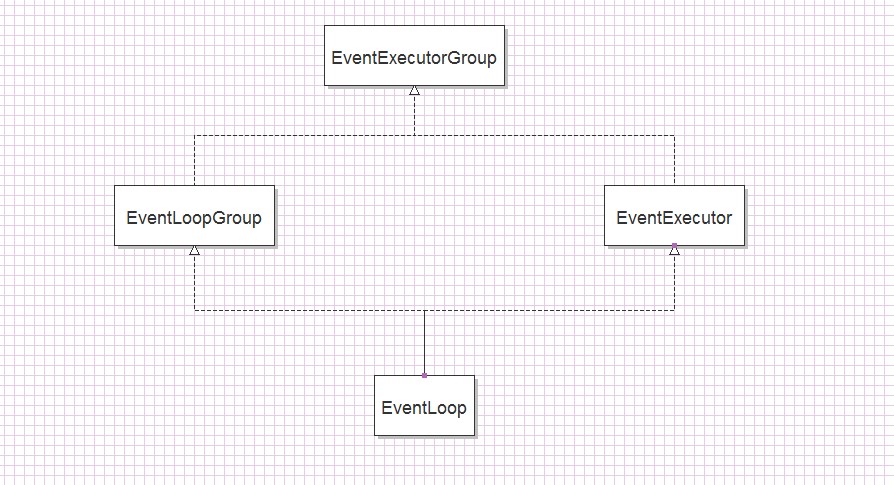现在算是正式开始进入Netty的源码了吧,首先从事件循环的执行部分开始吧,上图就是顶层的几个接口之间的关系,首先我们来看最上层的EventExecutorGroup
public interface EventExecutorGroup extends ScheduledExecutorService, Iterable<EventExecutor> {
/**
* Returns {@code true} if and only if this executor was started to be
* {@linkplain #shutdownGracefully() shut down gracefuclly} or was {@linkplain #isShutdown() shut down}.
*/
boolean isShuttingDown(); //
/**
* Shortcut method for {@link #shutdownGracefully(long, long, TimeUnit)} with sensible default values.
*/
void shutdownGracefully();
/**
* Signals this executor that the caller wants the executor to be shut down. Once this method is called,
* {@link #isShuttingDown()} starts to return {@code true}, and the executor prepares to shut itself down.
* Unlike {@link #shutdown()}, graceful shutdown ensures that no tasks are submitted for <i>'the quiet period'</i>
* (usually a couple seconds) before it shuts itself down. If a task is submitted during the quiet period,
* it is guaranteed to be accepted and the quiet period will start over.
*
* @param quietPeriod the quiet period as described in the documentation
* @param timeout the maximum amount of time to wait until the executor is {@linkplain #shutdown()}
* regardless if a task was submitted during the quiet period
* @param unit the unit of {@code quietPeriod} and {@code timeout}
*/
void shutdownGracefully(long quietPeriod, long timeout, TimeUnit unit);
/**
* @deprecated {@link #shutdownGracefully(long, long, TimeUnit)} or {@link #shutdownGracefully()} instead.
*/
@Override
@Deprecated
void shutdown();
/**
* @deprecated {@link #shutdownGracefully(long, long, TimeUnit)} or {@link #shutdownGracefully()} instead.
*/
@Override
@Deprecated
List<Runnable> shutdownNow();
/**
* Returns one of the {@link EventExecutor}s that belong to this group.
*/
EventExecutor next();
/**
* Returns a read-only {@link Iterator} over all {@link EventExecutor}, which are handled by this
* {@link EventExecutorGroup} at the time of invoke this method.
*/
@Override
Iterator<EventExecutor> iterator();
@Override
Future<?> submit(Runnable task);
@Override
<T> Future<T> submit(Runnable task, T result);
@Override
<T> Future<T> submit(Callable<T> task);
@Override
ScheduledFuture<?> schedule(Runnable command, long delay, TimeUnit unit);
@Override
<V> ScheduledFuture<V> schedule(Callable<V> callable, long delay, TimeUnit unit);
@Override
ScheduledFuture<?> scheduleAtFixedRate(Runnable command, long initialDelay, long period, TimeUnit unit);
@Override
ScheduledFuture<?> scheduleWithFixedDelay(Runnable command, long initialDelay, long delay, TimeUnit unit);
}
方法也都比较基础,无非就是一些提交任务,取出可用的EventExecutor,关闭执行器等等。。。
接下来来看EventExecutor接口的定义
public interface EventExecutor extends EventExecutorGroup {
/**
* Returns a reference to itself.
*/
@Override
EventExecutor next();
/**
* Return the {@link EventExecutorGroup} which is the parent of this {@link EventExecutor},
*/
EventExecutorGroup parent();
/**
* Calls {@link #inEventLoop(Thread)} with {@link Thread#currentThread()} as argument
*/
boolean inEventLoop();
/**
* Return {@code true} if the given {@link Thread} is executed in the event loop,
* {@code false} otherwise.
*/
boolean inEventLoop(Thread thread);
/**
* Return a new {@link Promise}.
*/
<V> Promise<V> newPromise();
/**
* Create a new {@link ProgressivePromise}.
*/
<V> ProgressivePromise<V> newProgressivePromise();
/**
* Create a new {@link Future} which is marked as successes already. So {@link Future#isSuccess()}
* will return {@code true}. All {@link FutureListener} added to it will be notified directly. Also
* every call of blocking methods will just return without blocking.
*/
<V> Future<V> newSucceededFuture(V result);
/**
* Create a new {@link Future} which is marked as fakued already. So {@link Future#isSuccess()}
* will return {@code false}. All {@link FutureListener} added to it will be notified directly. Also
* every call of blocking methods will just return without blocking.
*/
<V> Future<V> newFailedFuture(Throwable cause);
}接下来再来看EventLoopGroup的定义:
public interface EventLoopGroup extends EventExecutorGroup {
/**
* Return the next {@link EventLoop} to use
*/
@Override
EventLoop next();
/**
* Register a {@link Channel} with this {@link EventLoop}. The returned {@link ChannelFuture}
* will get notified once the registration was complete.
*/
ChannelFuture register(Channel channel);
/**
* Register a {@link Channel} with this {@link EventLoop}. The passed {@link ChannelFuture}
* will get notified once the registration was complete and also will get returned.
*/
ChannelFuture register(Channel channel, ChannelPromise promise);
}
最后来看EventLoop的定义:
public interface EventLoop extends EventExecutor, EventLoopGroup {
@Override
EventLoopGroup parent();
}








 本文详细介绍了Netty中事件循环的实现原理,包括EventExecutorGroup、EventExecutor、EventLoopGroup和EventLoop等核心接口的功能及相互关系。
本文详细介绍了Netty中事件循环的实现原理,包括EventExecutorGroup、EventExecutor、EventLoopGroup和EventLoop等核心接口的功能及相互关系。


















 被折叠的 条评论
为什么被折叠?
被折叠的 条评论
为什么被折叠?








